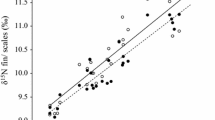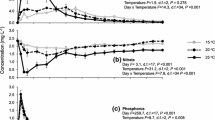Abstract
Dead animals may be an important or the only source of tissues to analyze for stable isotopes, with the goal of making inferences about an animal’s past ecological history. However, in nature, stable isotope values may be affected by myriad decomposition processes, such as abiotic environmental conditions and bacterial and fungal decay, potentially reducing the accuracy of derived ecological conclusions. We used Pacific salmon carcasses left in air or submerged under water to test whether stable isotope values of metabolically active (skin, muscle, and adipose fin) and inactive (scale) tissues changed over time. We found that the δ13C values of active tissues were all affected by decomposition but not in a predictable direction, and hard scale tissue was not. In contrast, there was no effect on δ15N values for any tissue up to 4 days under water or 8 days in air. This suggests that tissues can be analyzed for nitrogen stable isotope values even after several days in water and even if covered in fungus on the surface. For populations within which dead animals are frequently encountered, e.g., salmonid carcass surveys, hard tissues of fish (scales, otoliths) and other animals (baleen, bone, hair, feathers) will likely yield relevant biological information even if soft tissue is rotting, providing another avenue to collect important data about the life history of those animals.



available at day 4; no water samples at day 8

Similar content being viewed by others
References
Arthur KE, Boyle MC, Limpus CJ (2008) Ontogenetic changes in diet and habitat use in green sea turtle (Chelonia mydas) life history. Marine Ecol Prog Series 362:303–311
Balzer A, Gleixner G, Grupe G, Schmidt HL, Schramm S, Turban-Just S (1997) In vitro decomposition of bone collagen by soil bacteria: the implications for stable isotope analysis in archaeometry. Archaeometry 39(2):415–429
Barrow LM, Bjorndal KA, Reich KJ (2008) Effects of preservation method on stable carbon and nitrogen isotope values. Physiol Biochem Zool 81(5):688–693
Blight LK, Hobson KA, Kyser TK, Arcese P (2015) Changing gull diet in a changing world: a 150-year stable isotope (δ13C, δ15N) record from feathers collected in the Pacific Northwest of North America. Global Change Biol 21(4):1497–1507
Bolnick DI, Svanbäck R, Fordyce JA, Yang LH, Davis JM, Hulsey CD, Forister ML (2003) The ecology of individuals: incidence and implications of individual specialization. Am Nat 161(1):1–28
Bosley KL, Wainright SC (1999) Effects of preservatives and acidification on the stable isotope ratios (15N: 14N, 13C: 12C) of two species of marine animals. Can J Fish Aquat Sci 56(11):2181–2185
Bostic JN, Palafox SJ, Rottmueller ME, Jahren AH (2015) Effect of baking and fermentation on the stable carbon and nitrogen isotope ratios of grain-based food. Rapid Commun Mass Sp 29(10):937–947
Bugoni L, McGill RA, Furness RW (2008) Effects of preservation methods on stable isotope signatures in bird tissues. Rapid CommunMass Sp 22(16):2457–2462
Burrows DG, Reichert WL, Bradley Hanson M (2014) Effects of decomposition and storage conditions on the δ13C and δ15N isotope values of killer whale (Orcinus orca) skin and blubber tissues. Marine Mammal Sci 30(2):747–762
Dannheim J, Struck U, Brey T (2007) Does sample bulk freezing affect stable isotope ratios of infaunal macrozoobenthos? J Exp Mar Biol Ecol 351(1–2):37–41
Davis CP (1976) Preservation of gastrointestinal bacteria and their microenvironmental associations in rats by freezing. Appl Environ Microbiol 31(2):304–312
DeNiro MJ, Epstein S (1978) Influence of diet on the distribution of carbon isotopes in animals. Geochim Cosmochim Acta 42:495
Dent BB, Forbes SL, Stuart BH (2004) Review of human decomposition processes in soil. Environ Geol 45(4):576–585
Espinasse B, Hunt BP, Coll YD, Pakhomov EA (2019) Investigating high seas foraging conditions for salmon in the North Pacific: Insights from a 100-year scale archive for Rivers Inlet sockeye salmon. Can J Fish Aquati Sci 76(6):918–927
Fenton GE, Ritz DA (1988) Changes in carbon and hydrogen stable isotope ratios of macroalgae and seagrass during decomposition. Estuar Coast Shelf Sci 26(4):429–436
Fernandez I, Mahieu N, Cadisch G (2003) Carbon isotopic fractionation during decomposition of plant materials of different quality. Glob Biogeochem Cycles. https://doi.org/10.1029/2001GB001834
Feuchtmayr H, Grey J (2003) Effect of preparation and preservation procedures on carbon and nitrogen stable isotope determinations from zooplankton. Rapid Commun Mass Sp 17(23):2605–2610
Frossard J, Renaud O (2019) permuco: permutation tests for regression, (Repeated Measures) ANOVA/ANCOVA and comparison of signals. R package version 1.1.0. https://CRAN.R-project.org/package=permuco
Guiry EJ, Needs-Howarth S, Friedland KD, Hawkins AL, Szpak P, Macdonald R, Courtemanche M, Holm E, Richards MP (2016) Lake Ontario salmon (Salmo salar) were not migratory: a long-standing historical debate solved through stable isotope analysis. Sci Rep 6(1):1–7
Hobson KA, Gloutney ML, Gibbs HL (1997) Preservation of blood and tissue samples for stable-carbon and stable-nitrogen isotope analysis. Can J Zool 75(10):1720–1723
Hothorn T, Hornik K, van de Wiel MA, Zeileis A (2006) A Lego system for conditional inference. The Am Stat 60(3):257–263
Hothorn T, Hornik K, van de Wiel MA, Zeileis A (2008) Implementing a class of permutation tests: the coin package. J Stat Softw 28(8):1–23
Johnson SP, Schindler DE (2009) Trophic ecology of Pacific salmon (Oncorhynchus spp.) in the ocean: a synthesis of stable isotope research. Ecol Res 24(4):855–863
Johnson SP, Schindler DE (2012) Four decades of foraging history: stock-specific variation in the carbon and nitrogen stable isotope signatures of Alaskan sockeye salmon. Marine Ecol Prog Series 460:155–167
Kassambara A (2020) Rstatix: pipe-friendly framework for basic statistical tests. R package version 0.6.0. https://CRAN.R-project.org/package=rstatix
Keenan SW, DeBruyn JM (2019) Changes to vertebrate tissue stable isotope (δ 15 N) composition during decomposition. Sci Rep 9(1):1–12
Kelly B, Dempson JB, Power M (2006) The effects of preservation on fish tissue stable isotope signatures. J Fish Biol 69(6):1595–1611
Kim MS, Lee WS, Suresh Kumar K, Shin KH, Robarge W, Kim M, Lee SR (2016) Effects of HCl pretreatment, drying, and storage on the stable isotope ratios of soil and sediment samples. Rapid Commun Mass Sp 30(13):1567–1575
Layman CA, Araujo MS, Boucek R, Hammerschlag-Peyer CM, Harrison E, Jud ZR, Matich P, Rosenblatt AE, Vaudo JJ, Yeager LA, Post DM (2012) Applying stable isotopes to examine food-web structure: an overview of analytical tools. Biol Rev 87(3):545–562
Macko SA, Engel MH, Qian Y (1994) Early diagenesis and organic matter preservation—a molecular stable carbon isotope perspective. Chem Geol 114(3–4):365–379
Matthews B, Mazumder A (2004) A critical evaluation of intrapopulation variation of δ 13 C and isotopic evidence of individual specialization. Oecologia 140(2):361–371
McGoldrick DJ, Barton DR, Power M, Scott RW, Butler BJ (2008) Dynamics of bacteria–substrate stable isotope separation: dependence on substrate availability and implications for aquatic food web studies. Can J Fish Aquat Sci 65:1983–1990
Micozzi MS (1986) Experimental study of postmortem change under field conditions: effects of freezing, thawing, and mechanical injury. J Forensic Sci 31(3):953–961
Newsome SD, Yeakel JD, Wheatley PV, Tinker MT (2012) Tools for quantifying isotopic niche space and diet variation at the individual and population level. J Mammal 93(2):329–341
Patterson DA, Skibo KM, Barnes DP, Hills JA, Macdonald JS (2007) The influence of water temperature on time to surface for adult sockeye salmon carcasses and the limitations in estimating salmon carcasses in the Fraser River, British Columbia. North Ame J Fish Manag 27(3):878–884
Payo-Payo A, Ruiz B, Cardona L, Borrell A (2013) Effect of tissue decomposition on stable isotope signatures of striped dolphins Stenella coeruleoalba and loggerhead sea turtles Caretta caretta. Aquat Biol 18(2):141–147
Perkins MJ, Mak YK, Tao LS, Wong AT, Yau JK, Baker DM, Leung KM (2018) Short-term tissue decomposition alters stable isotope values and C: N ratio, but does not change relationships between lipid content, C: N ratio, and Δδ13C in marine animals. PloS one 13(7):e0199680
Pinnegar JK, Polunin NVC (1999) Differential fractionation of δ13C and δ15N among fish tissues: implications for the study of trophic interactions. Funct Ecol 13:225–231
Ponsard S, Amlou M (1999) Effects of several preservation methods on the isotopic content of Drosophila samples. C R Acad Sci III 322:35
Qin Y, Kaeriyama M (2016) Feeding habits and trophic levels of Pacific salmon (Oncorhynchus spp.) in the North Pacific Ocean. N Pac Anadromous Fish Com Bul 6:469–481
R Core Team (2020) R: A language and environment for statistical computing. R Foundation for Statistical Computing, Vienna, Austria. URL https://www.R-project.org/.
Rubenstein DR, Hobson KA (2004) From birds to butterflies: animal movement patterns and stable isotopes. TREE 19(5):256–263
Schweizer M, Fear J, Cadisch G (1999) Isotopic (13C) fractionation during plant residue decomposition and its implications for soil organic matter studies. Rapid Commun Mass Sp 13(13):1284–1290
Šuláková H, Harakalová L, Barták M (2014) Effect of freezing on the initial colonization of the carcass with necrophagous organisms. Acta Musei Silesiae Sci Nat 63(1):29–37
Vander Zanden MJ, Clayton MK, Moody EK, Solomon CT, Weidel BC (2015) Stable isotope turnover and half-life in animal tissues a literature synthesis. PloS one 10(1):e0116182
Wheeler TA, Kavanagh KL (2017) Soil biogeochemical responses to the deposition of anadromous fish carcasses in inland riparian forests of the Pacific Northwest, USA. Can J Forest Res 47:1506–1516
Wild LA, Chenoweth EM, Mueter FJ, Straley JM (2018) Evidence for dietary time series in layers of cetacean skin using stable carbon and nitrogen isotope ratios. Rapid Commun Mass Sp 32(16):1425–1438
Willis TJ, Sweeting CJ, Bury SJ, Handley SJ, Brown JCS, Freeman DJ, Cairney DG, Page MJ (2013) Matching and mismatching stable isotope (δ 13 C and δ 15 N) ratios in fin and muscle tissue among fish species: a critical review. Marine Biol 160(7):1633–1644
Wolf JM, Johnson B, Silver D, Pate W, Christianson K (2016) Freezing and fractionation: effects of preservation on carbon and nitrogen stable isotope ratios of some limnetic organisms. Rapid Commun Mass Sp 30(5):562–568
Xu J, Yang Q, Zhang M, Zhang M, Xie P, Hansson LA (2011) Preservation effects on stable isotope ratios and consequences for the reconstruction of energetic pathways. Aquat Ecol 45(4):483–492
Yurkowski DJ, Hussey AJ, Hussey NE, Fisk AT (2017) Effects of decomposition on carbon and nitrogen stable isotope values of muscle tissue of varying lipid content from three aquatic vertebrate species. Rapid Commun Mass Sp 31(4):389–395
Acknowledgements
We thank Robert de Bruijn, Andrew Lotto, Rebecca Riley, and Steve Hall for field and logistic support. We also thank the St'at'imc First Nation, in particular Bonnie Adolph and St'at'imc Eco Resources (SER), for allowing access to the study site and for assisting with research coordination.
Supplementary Information
Data are included in supplementary material.
Funding
Funding was provided through BCHydro and SER to SGH, the Natural Sciences and Engineering Research Council of Canada Discovery Grants to SGH, SJC and MP, the Canada Research Chairs program for SJC, and the DFO Environmental Watch Program to DAP.
Author information
Authors and Affiliations
Corresponding author
Ethics declarations
Conflict of interest
The authors declare no conflicts of interest/competing interests.
Additional information
Publisher's Note
Springer Nature remains neutral with regard to jurisdictional claims in published maps and institutional affiliations.
Handling Editor: Télesphore Sime-Ngando.
Supplementary Information
Below is the link to the electronic supplementary material.
Rights and permissions
About this article
Cite this article
Peiman, K.S., Lin, HY., Power, M. et al. Effects of short-term decomposition on isotope values of fish tissues under natural conditions. Aquat Ecol 56, 173–181 (2022). https://doi.org/10.1007/s10452-021-09907-9
Received:
Accepted:
Published:
Issue Date:
DOI: https://doi.org/10.1007/s10452-021-09907-9




